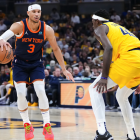
Two days after the death of an Olympic gold medalist sailor during a training run on San Francisco Bay, the head of the America’s Cup said on Saturday that he still expects this summer’s event to take place in spite of the tragedy.
Stephen Barclay, CEO of the America’s Cup Event Authority, said during a press conference he will wait until the findings of an internal investigation are complete before making an official decision. The CEO will also wait to decide if enhanced safety measures must be undertaken with the course or the boats for the 34th renewal of the America’s Cup that begins in July.
Andrew Simpson, a gold medalist in the Star class at the 2008 Beijing Summer Olympics, died on Thursday afternoon when his Artemis Racing team’s 72-foot yacht capsized outside Treasure Island. Simpson became trapped under the catamaran after it flipped it over. Efforts to resuscitate the British sailor afloat and subsequently ashore were unsuccessful.
"There's a lot of speculation of what happened," Barclay said. "We want to end the speculation."
The investigation will be headed by regatta director Iain Murray. While Murray has yet to view video footage of the accident, he said the boat attempted to change direction just before it capsized. The maneuver, Murray added, was not out of the ordinary.
“The boat nose-dived, and all that we know from that point in that maneuver is that the boat ended up upside down, capsized, broken into many pieces," Murray said.
Investigators will focus on whether structural damage to the AC72 catamaran played a role in the mishap. Last October, Artemis delayed a champagne-filled ceremony to toast the launching of the boat when they discovered that it incurred damage during tow testing. At the time, Laurent Esquirer, the Chief Operating Officer of Artemis Racing, expressed concern with the yacht’s carbon fiber frame, its primary construction material.
“(Carbon fiber) is a strange animal,” Esquirer said. “You hear noises and you just don’t know. We need to do our due diligence and assess the integrity of the structure.”
Thursday’s accident was not the first in San Francisco Bay during training for the Cup. Oracle Team USA, the defending Cup champions, also had a boat capsize, amid strong currents last October. Heavy winds caused the nose of the yacht to plow underwater, as the catamaran toppled over, sending its 13-story tall wing sail under the waves. Conditions were more manageable on Thursday, according to Murray, as the tide in the Bay was ebbing at around 2-3 knots and the wind was at 18-20 knots.
“Ideal sailing conditions, flat water -- a very typical San Francisco day,” Murray said.
When Oracle defeated Alinghi to win the Cup in 2010, the team raced in a 72-foot catamaran with a state-of-the art wing sail. The wing sail has characteristics of an airplane wing, which helps the yacht generate added speed. When the catamaran’s gigantic hull lifts out of the water, it glides along the waves reducing the drag on the boat. Oracle owner Larry Ellison and other team members opted to defend the America’s Cup with the faster boats.
With the added speed and the two accidents over the last eight months, safety concerns have mounted. At the time of Thursday’s incident, Oracle Team USA had also been in the midst of a training run on San Francisco Bay.
“Neither crew out on the Bay was doing anything they hadn’t done many times before,” Murray said. “They practice, they bear away, they reach and they go into gybing maneuvers. Generally, that is how they fulfill their day as they try to perfect the performance of their boat.”
Keep your eye on sports by following Matt Rybaltowski on Twitter@mattrybaltowski.



















